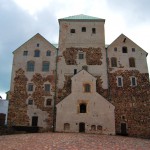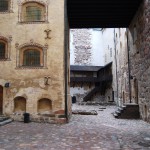Turku Castle (Finland)
TurkuCastle, Castle Abo (Swedish – Åbo slott, Finnish Turun linna) — is a Swedish castle in Turku which gained most of its modern appearance during the reign of Gustav Vasa.
Turku castle is one of the most outstanding medieval castles of Finland. From time to time, it played a significant role in the history of Sweden and countries of the northern Europe. The castle is situated at the mouth of the AuraRiver. Originally – probably at the end of the XIII century, the Swedish king ordered to build on the site of the future castle a fortified camp after the Varsinais-Suomi (the south-west part of Finland) was included into the Swedish kingdom. During the Middle Ages and later – in the XVI century, in the Renaissance period, the castle was rebuilt and expanded many times.
In the beginning of the Modern Era, due to the changes caused by military actions in Europe, the medieval castles lost their significance. Starting from the end of the XVI century, the Castle in Turku was used primarily as a prison and a store. And from the end of the XIX century, it served as a museum, although it was significantly damaged in the summer of 1941 after the city was bombed by the Soviet air forces. Because of this, after the World War II, there was a need to do major rebuilding and restoration works in the castle.
At the present moment, TurkuCastle is included among the most important monuments of the history of construction in Finland. In the castle’s rooms the museum of Turku’s history functions which is affiliated with the regional Museum of Turku. Also, the castle’s chapel is quite popular as a wedding venue, and the Renaissance halls of the castle can be rented for celebrations. Among other things, medieval feasts are held in the castle’s café-restaurant for common people.
The construction works were started in TurkuCastle at the time when the South-west Finland was included into the SwedishKingdom.
The King of Sweden in the Middle ages had to build that part of the kingdom which was called the Eastland, that is, to build fortresses for defense and development of administration centers. Along with Turku castle, VyborgCastle, HameenlinnaCastle, RaaseporiCastle, and OlavinlinnaCastle were later built.
In the 1280s, or in the beginning of the XIV century, fortified camps were built at the mouth of the AuraRiver, which were designated for the viceroy of the king of Sweden and royal soldiers. Probably, on this spot there already had been a wooden fortress. For the wars of the Middle Ages, strong fortified castles played the key role, and TurkuCastle was also first built on a island for defensive purposes. The location for the castle was fortunate, because it was difficult to surround it, and the defenders of the fortress could watch the ships that sailed on the AuraRiver, and maintain sea traffic with Sweden. Besides, the main purpose of Turku fortress was to protect the medieval Turku city that was built around the Turku Cathedral.
Archeological surveys and construction history researches show that originally TurkuCastle was built according to the patterns received from Gotland. Grey granite was used as the building material, later – bricks. Limestone blocks brought from Gotland could also be used in finishing details. In the XIV-XV centuries, TurkuCastle was expanded at different stages of construction, especially in the second half of the XV century, during the rule of regent Sten Sture the Elder. The oldest medieval part of the castle, that is, the main fortress (the keep), is rectangular in shape, in its west and east ends there are solid square towers. The long sides of the keep look like the wings of constructions four storey high. The courtyard of the main castle is enclosed by the walls, and in the Middle ages there was a partition wall in its center that divided the castle according to the pattern of medieval European castles into two sections – the upper ward (palace) and the lower ward. In the XVth century, outside the main fortress a new fortification was additionally built which was called the bailey.
Turku Fortress, like many other medieval fortresses, was designated for military use, and in the fortress, under the fort’s chief commander or under the royal viceroy, a garrison was under arms. On top of it, in the Middle ages the castle was also an important administrative center, and, for instance, while the Swedish kings visited Finland, they stayed at TurkuCastle. At times, for example in the XIV century, when the fort’s commander was Mathias Kettilmudson, the fort lived the court’s life. TurkuCastle, especially during the time of the Kalmar Union, quite often became the scene of inner state political strife. The longest and most famous siege in the castle’s history happened in 1364-1365, when Albert of Miklenborg with his military forces took the fortress after more than eight months of siege, suppressing the resistance of troops faithful to Magnus Eriksson.
The castle is not the first of its kind in this region. The fortification which is much older, the one that controls inland navigation on the AuraRiver – “The Old Castle” (Finnish - Liedon Vanhalinna), was located up the stream on top of a high hill (47 meters above the river surface). It was captured by the Swedish circa 1000, and was used by them all the way until 1370. It lost its significance due to the elevation of the dry land and because of the sandbanks that were formed in the river at Halinen. The castle of a Catholic priest in Kuusito (Finnish, Kuusiston piispanlinna), mentioned in 1295, was also built on a sea island, but it did not control the Aura’s estuary and required additional forces to defend it. After being captured by the enemy, it turned into a convenient base for the enemy. This is what happened in 1522, when the Danes took the castle from the sea. The guns had been earlier transported to Turku to support the Swedish attempts to fight the Danes off from the TurkuCastle itself. King Gustav I Vasa ordered to demolish it in 1528. Presumably, it was used as building materials for the bailey of TurkuCastle.
About the same time, the rise of the dry land connected the skerry, upon which the castle was founded, with the main land. The Castle’s defense was gradually shifted to the bailey from the keep, and further – to new territories. During the castle’s time, the dry land rose for 3-5 meters.
King Gustav Vasa cancelled the Kalmar Union in 1523, and founded in his country a hereditary monarchy. Gustav Vasa also visited TurkuCastle quite often, and he initiated large scale remodeling works in the castle, as well as its expansion. During the XVI century, for example, the bailey that was built outside the main castle, acquired its modern appearance. The bailey in its modern appearance is a square group of buildings with a pentagonal tower in its north end, hexagonal tower in its south wing, and rectangular tower in the central section of the east side of the wall. Moreover, in the east corner of the front fort there is a turret.
In Early Modern era, due to the changes in the war tactics, medieval fortresses started to lose their significance. Also, the defense of TurkuCastle was gradually shifted outside the main medieval castle into the front fort and redoubts.
Since the main castle lost its original significance from the military point of view, during the reign of Gustav Vasa it could be turned into a residential palace in Renaissance style according to German, Spanish, and Polish patterns. During the renovation works in the main castle, a new upper floor was built. Proper modernizations were carried out in the XVI century in many other fortresses of state importance also, for example, in Kalmar fortress
Gustav Vasa’s son, duke Johan, future king of Sweden Johan III, lived in TurkuCastle in 1556-1563. Gustav Vasa appointed Johan Duke of Finland in 1556. After Johan moved to TurkuCastle, the fortress that was once designated for military defense turned into a Renaissance palace. The Duke’s court at TurkuCastle was a unique time of splendour in Finland’s setting and the only example of royal life in the Renaissance style in the country. Johan married Katarina Jagellonica, a daughter of the Polish king, and she also moved into TurkuCastle for a while. Together with the appearing of Katarina at the court of Duke Johan, cultural influences were brought in, especially of the Renaissance times, from Italy and Poland. The castle in the context of Finland was a powerful institution, where over 600 people worked, most of whom were women. Concerning Duke Johan they say that he was a ruler who knew a great deal about fashion, and his demeanor caused admiration overseas as well. Luxurious feasts were held at the castle, and on the closest island Ruissalo knight tournaments were organized.
Succeeding after Gustav Vasa, Eric XIV who ascended to the throne, entered into an open confrontation with his brother Johan. When the conflict became bitter, the troops of Eric XIV in 1553 surrounded TurkuCastle and put the Duke and his wife under arrest. That put an end to the Renaissance court life in Turku. Later Johan shut up in a castle Eric’s wife and children, including Prince Gustav of Sweden.
After the XVI century, TurkuCastle was gradually dilapidating. Especially devastating for the castle was the fire of 1614, which started during the visit of Swedish king Gustav II Adolf and which especially damaged the main castle.
In the XVII century, the bailey was used as a residence of viceroys of Turku and Pori governorates. The Governor General of Finland, Count Peter Brahe, lived in the Castle while he was in Finland. After the XVII century, TurkuCastle was mainly used as a store and province’s prison. For example, the royal grain store and winery were lodged in the castle. In the XVIII and early XIX centuries, in TurkuCastle there was an arsenal of the Swedish Army, and later – barracks of the Swedish Royal Archipelago Fleet.
Starting from the end of the XIX century, the Turku historical museum has been functioning in TurkuCastle. After Finland gained its independence, a great number of archeological studies and researches on the history of construction were carried out in the castle and its vicinities. During the World War II, the castle was seriously damaged as the result of air bombings. The greatest damage it sustained during the bombing by the Soviet Air Forces that happened in the summer of 1941 in the beginning of the Great Patriotic War. When the World War II ended, extensive repairing and restoration works had to be done in the castle, the chief responsible architect for these works was functionalist Eric Brjuggman. The restoration works lasted between 1946 and 1961. At the same time, the responsible one for the carrying out of researches on archeology and history of construction was a state archeologist Carl Jacob Kardberg. At the present time in TurkuCastle the history museum of the city of Turku is functioning, which is affiliated with the RegionalMuseum of the City of Turku.
This material has been taken from the following web-resource: www. http://ru.wikipedia.org


